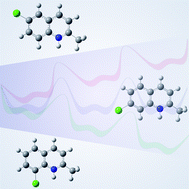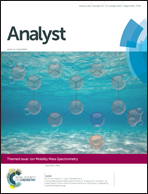Using differential mobility spectrometry to measure ion solvation: an examination of the roles of solvents and ionic structures in separating quinoline-based drugs†
Abstract
Understanding the mechanisms and energetics of ion solvation is critical in many scientific areas. Here, we present a methodlogy for studying ion solvation using differential mobility spectrometry (DMS) coupled to mass spectrometry. While in the DMS cell, ions experience electric fields established by a high frequency asymmetric waveform in the presence of a desired pressure of water vapor. By observing how a specific ion's behavior changes between the high- and low-field parts of the waveform, we gain knowledge about the aqueous microsolvation of that ion. In this study, we applied DMS to investigate the aqueous microsolvation of protonated quinoline-based drug candidates. Owing to their low binding energies with water, the clustering propensity of 8-substituted quinolinium ions was less than that of the 6- or 7-substituted analogues. We attribute these differences to the steric hinderance presented by subtituents in the 8-position. In addition, these experimental DMS results were complemented by extensive computational studies that determined cluster structures and relative thermodynamic stabilities.

- This article is part of the themed collection: Ion Mobility Mass Spectrometry

 Please wait while we load your content...
Please wait while we load your content...